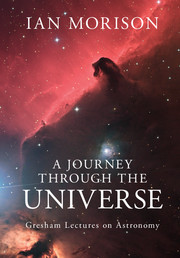Book contents
- Frontmatter
- Dedication
- Contents
- Preface
- Acknowledgements
- 1 Watchers of the skies
- 2 Our Sun
- 3 Aspects of our Solar System
- 4 The rocky planets
- 5 The hunt for Planet X
- 6 Voyages to the outer planets
- 7 Harbingers of doom
- 8 Impact!
- 9 Four hundred years of the telescope
- 10 The family of stars
- 11 Aging stars
- 12 The search for other worlds
- 13 Are we alone? The search for life beyond the Earth
- 14 Our island Universe
- 15 Wonders of the southern sky
- 16 Proving Einstein right
- 17 Black holes: no need to be afraid
- 18 It’s about time
- 19 Hubble’s heritage: the astronomer and the telescope that honours his name
- 20 The violent Universe
- 21 The invisible Universe: dark matter and dark energy
- 22 The afterglow of creation
- 23 To infinity and beyond: a view of the cosmos
- Index
- Plate section
- References
21 - The invisible Universe: dark matter and dark energy
Published online by Cambridge University Press: 05 October 2014
- Frontmatter
- Dedication
- Contents
- Preface
- Acknowledgements
- 1 Watchers of the skies
- 2 Our Sun
- 3 Aspects of our Solar System
- 4 The rocky planets
- 5 The hunt for Planet X
- 6 Voyages to the outer planets
- 7 Harbingers of doom
- 8 Impact!
- 9 Four hundred years of the telescope
- 10 The family of stars
- 11 Aging stars
- 12 The search for other worlds
- 13 Are we alone? The search for life beyond the Earth
- 14 Our island Universe
- 15 Wonders of the southern sky
- 16 Proving Einstein right
- 17 Black holes: no need to be afraid
- 18 It’s about time
- 19 Hubble’s heritage: the astronomer and the telescope that honours his name
- 20 The violent Universe
- 21 The invisible Universe: dark matter and dark energy
- 22 The afterglow of creation
- 23 To infinity and beyond: a view of the cosmos
- Index
- Plate section
- References
Summary
Perhaps the most amazing aspect of our Universe is that we only see about 1% (in the form of stars and bright nebulae) of its total mass and energy. A further 4% of its mass is in the form of dust and gas, but this leaves about 95% to be accounted for. A major element of this is, we believe, in the form of ‘dark matter’. It has been given this name as it does not interact with light and so is invisible but, due to the fact that it does have mass, it does exert a gravitational attraction on normal matter and this is how we have evidence for its existence.
The first question to ask is whether this invisible content is normal (baryonic) matter that just does not emit light, for instance gas, dust or objects such as brown dwarfs, neutron stars or black holes. These latter objects are called MACHOs (massive astronomical compact halo objects) as many would reside in the galactic halos that extend around galaxies.
- Type
- Chapter
- Information
- A Journey through the UniverseGresham Lectures on Astronomy, pp. 301 - 319Publisher: Cambridge University PressPrint publication year: 2014



